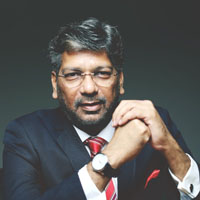Here's a closer look at what major trends we expect to see in India's CCTV and security market in 2021.
The Indian CCTV market is still relatively young. Although the number of cameras seen across major cities has increased over the past couple of years, their coverage is hardly ideal. And even when they do provide adequate coverage, their maintenance is a concern.
However, there is a growing awareness among the public about the importance of having CCTV cameras, as crime rates continue to remain unabated throughout the country. The research firm Mordor Intelligence expects the Indian CCTV market to grow at 22.5 percent between 2020 and 2025. This article explores the trends that experts anticipate in 2021.
 Sanjeev Sehgal
Sanjeev Sehgal
Founder and MD
Sparsh CCTV
-
Rise in popularity of made-in-India products
The Indian government has recently increased efforts to promote manufacturing in India. This has prompted many foreign manufacturers to consider making CCTV devices in India, with significant contributions from local components manufacturers.
“Many companies have started exploring these things in India, and everyone has to do it now because it has become a part of compliance,” explains Sanjeev Sehgal, Founder and MD of Sparsh CCTV. “The government has categorized the products into two – L1 and L2. Products made using more than 50 percent locally made components come under L1. Those that use between 20 and 50 percent of local components come under L2. For government projects, the products should either be L1 or L2; it cannot be imported.”
This means that foreign manufacturers who want to be part of the large-scale public projects will at least have to consider assembling their products in India while using some locally made components.
 Ashish Dhakan
Ashish Dhakan
CEO
Prama Hikvision India
-
Higher adoption of new camera tech
Significant changes have shaped the CCTV hardware during the last decade, and more exciting innovations should be expected in 2021. The latest research points to video everywhere, edge computing, and AI as the top technologies that will significantly impact both commercial and consumer markets.
“Computing at the edge means that the processors inside the camera are powerful enough to run AI processing locally, while still encoding and streaming video, and are able to do it all at the low-power required to fit into the limited thermal budget of an IP camera,” said Ashish Dhakan, CEO of Prama Hikvision India. “New chips will be able to perform all of the processing on the camera and provide accurate AI information, with no need to send data to a server or the cloud for processing.”
There are other emerging technologies and applications, as well. Multi-dimensional perception, UHD, low light imaging, artificial intelligence, and cloud technology, all of which might see more takers in 2021. We may see more
use cases of such solutions in the coming year.
-
More use of video analytics
India has traditionally been strong in software development, and this has extended to the video analytics segment. Today, several small and large companies aggressively work to develop advanced algorithms that are often used by customers across the globe. Within the Indian security market, the acceptance of video analytics and an awareness of its importance is catching up.
“With the evolution of the IP Camera and more intelligent software, video analytics has become more powerful and more promising,” Dhakan said. “Starting from the ubiquitous automatic face recognition, vehicle number plate recognition, and counting objects up to detecting loitering in an area and speed and direction of vehicles in motion. The whole new set of transformative technologies AI (Artificial Intelligence), Blockchain, IoT (Internet of Things), and Big Data has opened new vistas of opportunities for the software developers.”
-
Increased use of facial recognition for public safety
Facial recognition, in particular, warrants a more in-depth discussion because of its increased use in public security projects. Reports suggest that 16 different facial recognition systems are deployed in different parts of the country by the central and various state governments, while 17 more and in the process of being deployed.
“The railways have several surveillance cameras in use now, of which, a few at the entrance and exit are used for facial recognition as well,” Sehgal pointed out. “Other
verticals like airports are also using them, and going forward, even metro railways may begin to deploy facial recognition. They are also increasingly being considered for border security, with a pilot project in the Nepal border executed recently.”
-
More importance to cybersecurity
There is a global awareness of the importance of
cybersecurity in CCTV systems now. Sehgal pointed out that the Indian government recently announced cybersecurity of telecom as a critical factor. The Department of Telecom procures CCTV for public surveillance projects, and this brings surveillance systems under scrutiny. Any cybersecurity policy the government plans to enforce on telecom products would apply to CCTV devices too.
“Recently, a vendor for Delhi police was asked for the cybersecurity certification,” Sehgal continued. “The government has already considered compliances on the quality of infrastructure. Once a policy framework comes into the place, we believe that everyone would have to comply with it.”
 Rajiv Mathur
Rajiv Mathur
CEO
V4 Security Service
-
Higher emphasis on training
Security training is an area that India has not yet given much importance to. Rajiv Mathur, CEO of V4 Security Service, believes that there will be a lot of up-skilling of the workforce and training methodology changes.
“In last ten months, security guards or the security operations in terms of manpower team, has done phenomenally well,” Mathur explained. “They have done much more and much beyond their profile, whether it is a health check monitoring or other pandemic-prompted measures that have become a part of security now.”
In 2020, protection again COVID-19 was a responsibility that was suddenly thrust on security guards, with minimum training. In 2021, training for security guards will include measures to protect against COVID-19 or any other disease that may become a concern in the future.
Conclusion: regulations and pandemic to drive change
To sum up, the Indian security and CCTV market would see more regulations in the coming year, especially related to local manufacturing and cybersecurity. Customers would continue to explore more hardware and software as awareness of their benefits rises. Finally, safety would become an integral part of the security professional’s profile, emphasizing training to manage COVID-19 concerns.